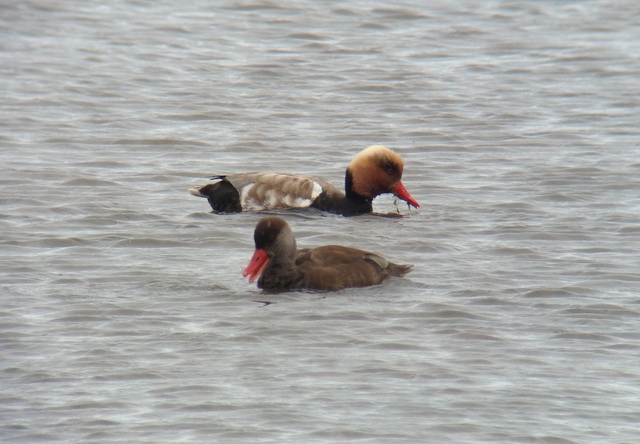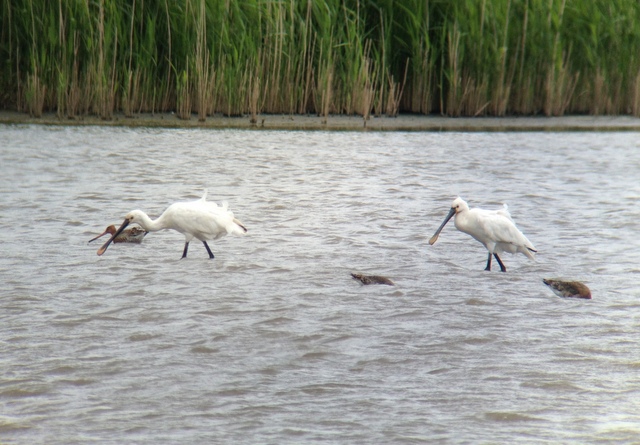Another Summer Tour today, in North Norfolk again. The idea was to go looking for birds of prey in the morning, but it didn’t go entirely according to plan. The weather forecasters let us down once again! We didn’t have much rain, it just fell at the wrong time. Still, an adjustment to the plans and we had a great day just the same.
We met in Wells, and headed inland to explore the farmland behind the coast. We hadn’t gone far when a Red Kite circled lazily over the field beside the road.
 Red Kite – this one from earlier in the morning
Red Kite – this one from earlier in the morning
We had a specific request to see a Little Owl today. This is a good time to the year to look for them, as they have young to feed at the moment and are more active in the morning and late afternoon. However, it was already a bit cloudy and cool, and spitting with rain as we drove round to some regular sites. There was no sign initially at the first place we tried. We were just driving away when a sharp-eyed passenger spotted one low in a small dead tree beside the road. A quick stop and reverse and the Little Owl eyed us nervously.
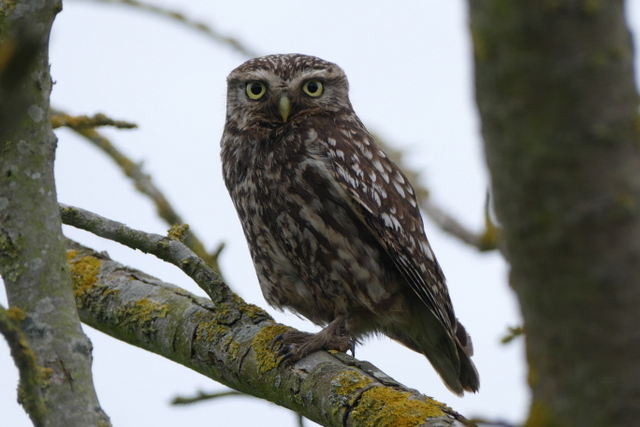 Little Owl – right beside the road, eyeing us nervously
Little Owl – right beside the road, eyeing us nervously
The Little Owl didn’t move and we even had a chance to drive on, get some more cameras out of the boot and return for another photo session from the other side of the car. Only as we drove off had it had enough and flew off back to its usual perch.
We stopped briefly at a favoured site for Turtle Doves, but there was no sign of them here again today. Some of the big overgrown hawthorn bushes that they normally favour were burnt when the farmer set fire his old straw stack recently and they don’t seem to be using the site as much now. However, there were lots of Skylarks singing and little groups of Linnets on the wires and down on the edge of the fields. We didn’t linger here and drove on.
At our next stop, we walked down along an overgrown footpath. There were Whitethroats and Yellowhammer singing from the high hedges either side, despite the cool and overcast weather. A pair of Bullfinches called from deep in the bushes. We flushed several Speckled Woods from along the track as we walked.
We had planned to scan for raptors from the higher ground. It had been spitting with rain on and off all morning, but the Met Office forecast had suggested only a 10% probability of rain before 12pm. We had just got out to a suitable vantage point when the it started falling a little harder. We stuck it out for a few minutes but there was very little activity, so we decided to have rethink. We headed back to the shelter of the car.
We had planned to visit Titchwell in the afternoon, but in the light of the weather we decided to drive over there earlier. Ironically, it promptly stopped raining as we drove (in fact, it didn’t rain at all between 12-2pm, when the rain was forecast!). However, the fields were wet still from the earlier rain and with the undergrowth so tall the birds were seeking dry ground. Lots of Yellowhammers flew up from along the side of the road as we drove, a pair of Stock Doves sat on the tarmac and refused to budge until we stopped right in front of them and edged forwards, and the Red-legged Partridges were out by the road as well.
A Brown Hare was drying itself off in some set aside by the road, in the drier short grass. It sat licking one of its feet for ages, unperturbed by our presence. Finally it lifted its head and looked at us, posing for the cameras.
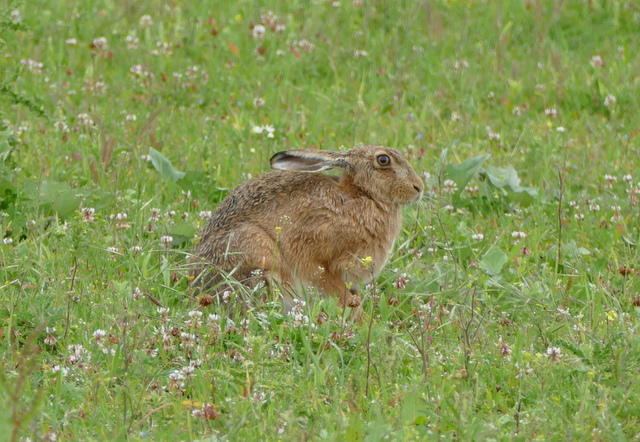 Brown Hare – out in the short grass after the rain
Brown Hare – out in the short grass after the rain
We stopped off at Choseley on our way to Titchwell. The area around the barns seemed quiet at first, but as we sat in the car scanning the bushes we glimpsed a Turtle Dove flying across the road behind us. We got out and looked up at the trees. At first sight we thought we might have been mistaken. A couple of Collared Doves and a Woodpigeon perched there preening. But a closer look revealed the Turtle Dove as well, perched half hidden amongst the foliage. We watched it for a while, preening.
 Turtle Dove – perched quietly in an oak tree preening
Turtle Dove – perched quietly in an oak tree preening
While we stood there, we picked up more birds as well. A Marsh Harrier was quartering the fields on the ridge. There were little groups of Goldfinches in the bushes beside the path, and a few Chaffinches and Yellowhammers on the wires. We had been hoping to see a Corn Bunting but there was no sign until we packed up to leave. Just at that moment, a Corn Bunting appeared on the wires, calling. It sat there for a minute, just long enough to get a good look at it, before dropping back down into the field.
Down at Titchwell, we still had some time before lunch, so walked out to Patsy’s Reedbed. Along the Fen Trail, there were lots of tits feeding in the sallows. A Chiffchaff appeared as well, dipping its tail constantly as it fed. Then a Reed Warbler stuck its head out too, out of the reeds and up in the tops of the bushes taking advantage of the mass of insects up there at the moment. We could hear Bullfinches calling but didn’t see one until we got out to Fen Hide and a lone bird flew over and down into the bushes out in the reedbed.
The first thing we saw at Patsy’s Reedbed was a couple of Red-crested Pochard. They looked rather like a pair but they were actually two males. The first was still mostly in full plumage, though already starting to moult. The second Red-crested Pochard looked rather like a dark and more contrasting version of the female, but when it lifted its head from feeding, we could see the bright coral red bill of an eclipse male. A scan of the rest of the ducks revealed another couple of eclipse males and a dark-billed female for comparison.
On one of the islands was a smallish wader, a Green Sandpiper. Again an early returning migrant, most likely either a non-breeder or failed breeder already making its way back south. We just had time to get it in the scope and have a good look at it before it flew off, calling loudly. With the water levels on Patsy’s Reedbed having fallen, the islands and muddy edges are now more attractive to waders. Along the near edge of the pool, two Little Ringed Plovers were lurking unseen amongst the vegetation and occasionally venturing out onto the mud.
After lunch, we walked out onto reserve. It was a bit breezy now, but still dry and even starting to brighten up. The warblers along the main path were less active today – a combination of the weather and the fact that they are busy raising young at the moment. There were still a couple of Reed Warblers singing, and a Cetti’s Warbler shouting from the sallows.
From Island Hide, we could see that the freshmarsh was alive with waders. The water levels look great at the moment, and they were taking advantage of the conditions to feed and sleep. There were at least 300 Black-tailed Godwits scattered over the water, mostly busy feeding. Around 100 Bar-tailed Godwits in contrast were mostly asleep, roosting on the freshmarsh over high tide out on the beach.
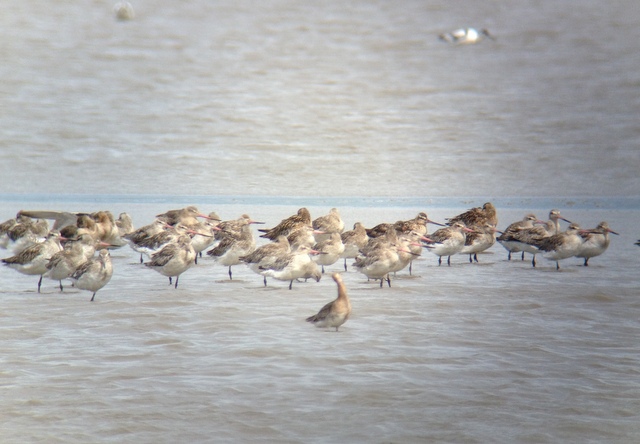 Godwits – large numbers of both Bar-tailed and Black-tailed on the freshmarsh
Godwits – large numbers of both Bar-tailed and Black-tailed on the freshmarsh
Looking more closely, we found a small number of Knot in amongst them, again most likely 1st summer birds in winter plumage. In contrast, two Dunlin were in smart summer plumage, still sporting full black belly patches. Amongst all the Black-tailed Godwits, we could see a couple of Spotted Redshanks feeding. The more we looked, the more we found, with another asleep in the middle of the throng of Bar-tailed Godwits. A fourth was feeding on its own further over. They were all still in smart black summer plumage, spangled with silvery-white spots on the upperparts, and with only small amounts of white winter feathering starting to appear on the underparts.
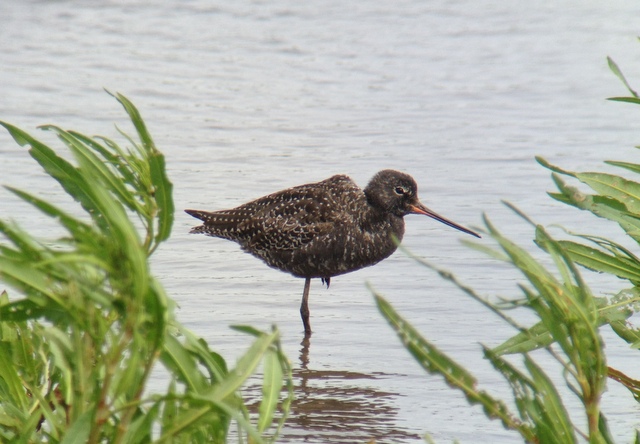 Spotted Redshank – looking very smart, still mostly in summer plumage
Spotted Redshank – looking very smart, still mostly in summer plumage
There were several Ruff out on the freshmarsh as well, similarly scattered amongst all the godwits and islands. The more we looked, the more we found. We counted at least 7 eventually and it was possible to identify them individually given the huge variation in the appearance of males. Almost all of them looked to be moulting males, apart from one bird in more female-like plumage.
 Ruff – a rather barred moulting male, note the remnants of the ornate ruff
Ruff – a rather barred moulting male, note the remnants of the ornate ruff
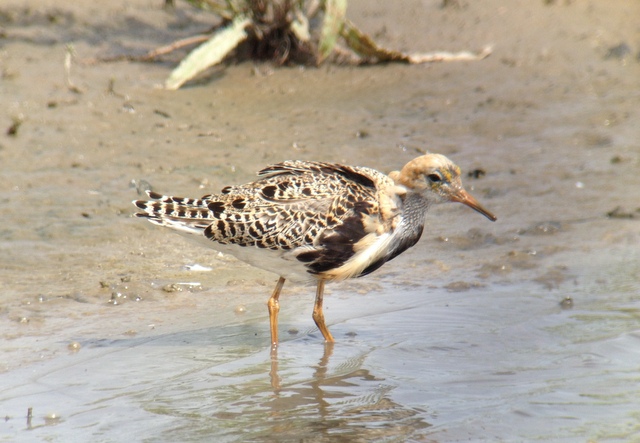 Ruff – a more garishly coloured moulting male, highlighting the wide variation
Ruff – a more garishly coloured moulting male, highlighting the wide variation
There were other waders out on the freshmarsh as well. A Ringed Plover was hiding on the edge of one of the islands, as was another Little Ringed Plover. The usual Lapwing and a large number of Avocet were also present. The latter performed very well for the cameras, as usual, feeding on the mud right in front of Island Hide.
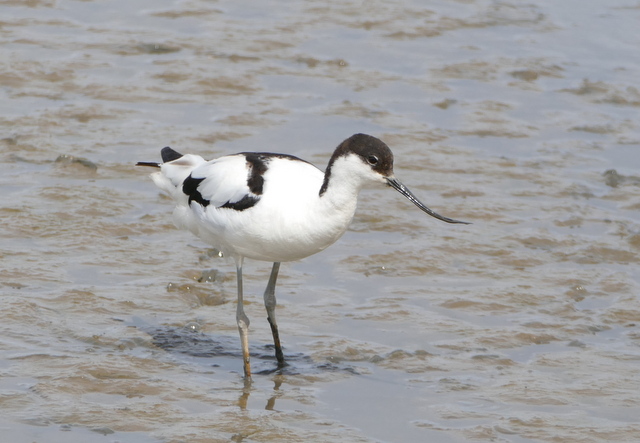 Avocet – the obligatory Titchwell photo
Avocet – the obligatory Titchwell photo
There were also lots of ducks, as usual, mostly Mallard, Gadwall and Shoveler. The drakes are starting to moult into drab eclipse plumage now. Two smaller ducks feeding in amongst the godwits caught the eye, but they spent almost all the time with their heads under water as they swam. Just occasionally they lifted them up and we could see the bold striped head pattern and pale bill spots – a couple of Garganey. A lone Brent Goose on one of the islands was also a surprise – there are thousands here in the winter, but not many in mid-summer.
There have been several Little Gulls on the freshmarsh for a few weeks now, and there were still three today, all 1st summer birds. They were scattered around the islands, feeding in the shallow water, picking at insects. In the middle of a large flock of roosting Black-headed Gulls on one of the islands, one jet black head gave away the presence of a sleeping adult Mediterranean Gull (ironically, the summer hood of Black-headed Gull is chocolate brown!).
 Little Gull – still three 1st summer birds on the freshmarsh
Little Gull – still three 1st summer birds on the freshmarsh
A large white shape appeared amongst the black Cormorants on the island at the very back of the freshmarsh. It was a Spoonbill. Several more edged out, but they were doing exactly what Spoonbills like to do most – sleeping! It was only when we got round to Parrinder hide that they suddenly woke up and walked out into the middle of the freshmarsh to feed, well four of them did at least. We could see one shorter-billed juvenile amongst them. The adults were feeding more proficiently but the youngster was obviously still learning and not fully equipped for the task!
The Volunteer Marsh and Tidal Pools were all fairly quiet, as they have been in recent weeks. Out on the beach, the tide was still in so there were no waders out there today. Further out over the sea towards Lincolnshire we could see a big flock of black shapes wheeling around low over the water, Common Scoter. We couldn’t make out any details on them at that distance, but thankfully a lone drake Common Scoter was closer in in front of us. Through the scope was could even see the yellow on the bill base.
There were lots of terns flying back and forth just offshore, including Sandwich and Little Terns to add to the Common Terns we had seen earlier on the freshmarsh. A single Gannet circled distantly to the west. Looking towards Brancaster, a single summer-plumage Great Crested Grebe was on the sea. Presumably a local bird popped out to feed, rather than a returning winter bird already!
Then it was unfortunately time to think about heading back. We looped round via the Meadow Trail. The sun was now shining and it was hot in the shelter of the sallows, out of the wind. The Southern Marsh Orchids on the meadow are now going over, but a couple by the path were still looking very smart. The birds we had seen earlier in the morning were still feeding in the bushes. And a Song Thrush was singing from the trees, serenading us as we walked back to the car.
